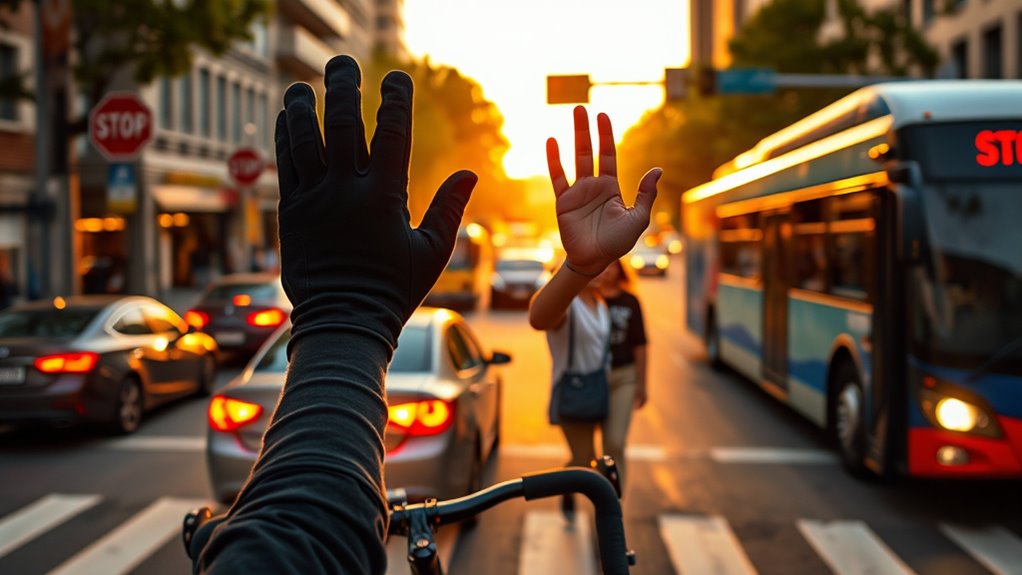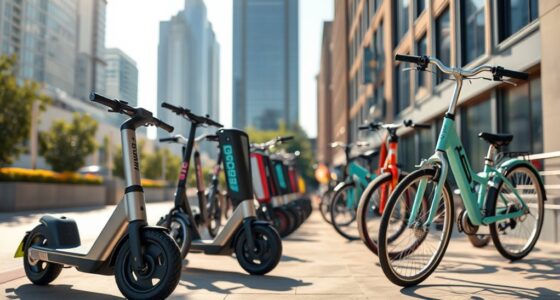In traffic, signals and body language are key for safe communication. You should pay attention to hand gestures like waves or signals that indicate turns and intentions. Making eye contact with other drivers or pedestrians helps confirm mutual understanding and prevent confusion. Using body language, such as nods or gestures, can clarify your actions and foster smoother interactions. Stay alert to these cues, as mastering them can markedly improve your safety on the road. Keep exploring to learn how to interpret these non-verbal signals effectively.
Key Takeaways
- Recognizing hand gestures and eye contact enhances mutual understanding and road safety among drivers and pedestrians.
- Specific signals, like raised hands or arm extensions, communicate turning intentions or stopping, reducing confusion.
- Eye contact confirms presence and intent, helping prevent misunderstandings at intersections and crossings.
- Non-verbal cues in shared spaces guide behaviors, such as yielding or slowing down, without relying solely on signals.
- Using body language effectively promotes clearer communication, quick reactions, and safer driving decisions.

Understanding signals and body language in traffic is essential for your safety and the safety of others on the road. Recognizing hand gestures and eye contact can help you anticipate other drivers’ actions and respond appropriately. When you see a driver making a hand gesture, it often communicates their intentions more clearly than words. For instance, a raised hand with the palm facing outward typically signals a wave to let you go ahead or acknowledge your presence. Conversely, a pointing finger or a specific gesture may indicate frustration or an attempt to direct your attention. Paying close attention to these gestures can prevent confusion and potential accidents.
Recognizing hand gestures and eye contact helps anticipate driver intentions and enhances road safety.
Eye contact plays a critical role in road safety because it establishes a connection between drivers and pedestrians or other motorists. When you make eye contact with another driver, you acknowledge each other’s presence and intent, reducing the chances of misunderstandings. For example, if a pedestrian looks at you before crossing, it’s a clear signal they intend to cross, and you should prepare to yield. Similarly, when a driver looks directly at you at an intersection, it often indicates they’re aware of your presence and may be about to turn or proceed. Eye contact can also serve as a way to communicate non-verbally in situations where verbal signals aren’t practical, such as at busy intersections or when dealing with aggressive drivers.
Using hand gestures and making eye contact is especially important in shared spaces like roundabouts, parking lots, and pedestrian crossings. You might see a driver extend their arm to signal a turn or slow down, which helps you understand their intentions without relying solely on brake lights or turn signals. Likewise, a driver who maintains eye contact with you at an intersection is often trying to clarify their movements or check if you’re about to proceed. These non-verbal cues are essential for safe navigation, as they reduce the likelihood of sudden stops or unexpected moves. Additionally, staying informed about crypto market trends and their influence on driver behavior can provide insights into unexpected traffic patterns or anomalies.
Always be aware of other drivers’ hand gestures and eye contact, and use your own body language to communicate clearly. A quick nod, a wave, or direct eye contact can make interactions smoother and safer. Remember, body language in traffic isn’t just about personal safety—it’s about creating a mutual understanding that keeps everyone on the road safe. Paying attention to these cues can help you react faster, make smarter decisions, and avoid dangerous situations.
Frequently Asked Questions
How Can I Interpret Hand Signals From Cyclists?
When you see hand signals from cyclists, you can understand cyclist communication easily. A left arm extended straight out means they’re turning left, while pointing right indicates a right turn. An extended left arm bent upward signals a stop or slowing down. Recognizing these hand signal meanings helps you anticipate their movements and stay safe. Always stay alert to cyclist communication to react promptly and maintain smooth traffic flow.
What Are Common Body Language Cues of Aggressive Drivers?
Aggressive drivers often display facial expressions that seem to scream anger, like clenched jaws or furrowed brows. They might make intense eye contact, glaring as if they’re challenging you to a duel. Their body language can include honking loudly, gesturing rudely, or leaning aggressively toward your vehicle. These cues signal hostility and impatience, warning you to stay calm and avoid escalation. Stay alert; their signals are loud enough to shake the road!
How Do Different Cultures Use Traffic Signals and Gestures?
You’ll notice that cultural variations markedly influence traffic signals and gesture meanings worldwide. In some countries, a raised hand might mean “stop,” while in others, it’s a friendly greeting. Gestures like thumbs-up or pointing can have different connotations depending on the culture. As a driver, you should understand these cultural distinctions to avoid misunderstandings and communicate effectively, respecting local customs and ensuring safety on the road.
Can Body Language Predict a Driver’s Intention to Change Lanes?
Yes, body language can often reveal a driver’s intention to change lanes. You might notice subtle signals, like a slight tilt of the head or a quick glance over the shoulder, hinting at an upcoming lane change. These cues, though small, are powerful indicators of a driver’s intention. Stay alert and observe carefully; sometimes, a quick movement can be a critical warning, giving you time to react and stay safe.
What Are the Legal Implications of Non-Verbal Signals in Traffic?
You should know that non-verbal signals in traffic can have serious legal consequences. If your body language or gestures lead to a misunderstanding, you could be held liable for accidents or traffic violations. Law enforcement may interpret ambiguous signals as negligence, affecting liability implications in court. Always guarantee your signals are clear and consistent to avoid legal trouble, as unclear body language can be used against you in legal proceedings.
Conclusion
As you navigate traffic, your signals and body language act like silent conversations, guiding others just as clearly as your words. Imagine a driver’s hand waving hello amid a sea of honking horns, or a quick glance that signals patience in chaos. These subtle cues create order in the chaos, turning a hectic street into a coordinated dance. Remember, your non-verbal cues are powerful tools—use them wisely to keep everyone safe and moving smoothly.
















